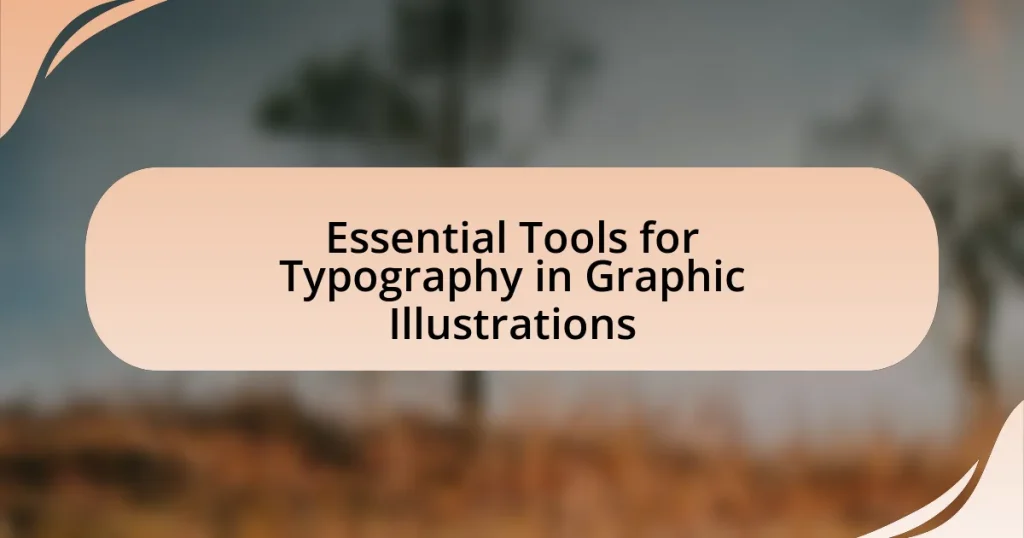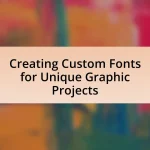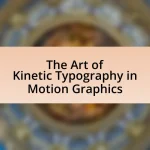The article focuses on the essential tools for typography in graphic illustrations, highlighting the importance of design software, typography libraries, and hardware. Key software such as Adobe Illustrator and InDesign provide advanced features for text manipulation, while typography libraries like Google Fonts enhance visual communication through diverse typefaces. The article also discusses how these tools improve the quality of graphic illustrations by ensuring precision, readability, and aesthetic appeal. Additionally, it covers best practices for selecting typography tools, common challenges faced by illustrators, and strategies to overcome these challenges, ultimately emphasizing the critical role of typography in effective visual communication.
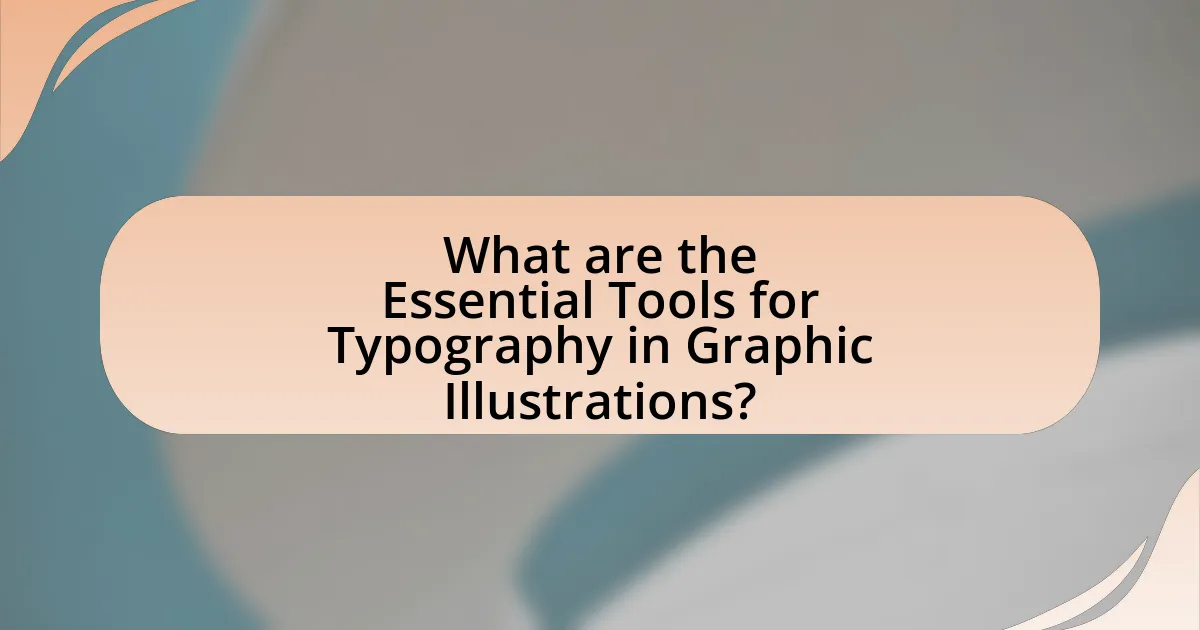
What are the Essential Tools for Typography in Graphic Illustrations?
The essential tools for typography in graphic illustrations include design software, typography libraries, and hardware. Design software such as Adobe Illustrator and InDesign provides comprehensive features for creating and manipulating text within illustrations. Typography libraries, including Google Fonts and Adobe Fonts, offer a wide range of typefaces that can enhance visual communication. Additionally, hardware like graphic tablets allows for precise control when designing typographic elements. These tools collectively enable designers to effectively integrate typography into their graphic illustrations, ensuring clarity and aesthetic appeal.
How do these tools enhance the quality of graphic illustrations?
These tools enhance the quality of graphic illustrations by providing precision, versatility, and efficiency in design processes. For instance, software like Adobe Illustrator allows for scalable vector graphics, ensuring that illustrations maintain clarity at any size. Additionally, typography tools enable designers to select and manipulate fonts effectively, improving readability and aesthetic appeal. Research indicates that well-chosen typography can increase viewer engagement by up to 50%, demonstrating the significant impact these tools have on the overall effectiveness of graphic illustrations.
What specific features make these tools effective for typography?
Effective typography tools possess features such as advanced font management, customizable text styles, and precise alignment options. Advanced font management allows users to easily organize and access a wide variety of typefaces, enhancing creativity and efficiency. Customizable text styles enable designers to modify attributes like size, weight, and spacing, ensuring that typography aligns with the overall design vision. Precise alignment options facilitate the accurate placement of text within layouts, contributing to visual harmony and readability. These features collectively enhance the effectiveness of typography tools in creating compelling graphic illustrations.
How do these tools integrate with graphic design software?
These tools integrate with graphic design software through plugins, APIs, and direct compatibility features that enhance typography capabilities. For instance, popular graphic design software like Adobe Illustrator and Photoshop often support third-party plugins that allow users to access advanced typography tools, such as variable fonts and text effects, directly within the design environment. Additionally, many typography tools offer APIs that enable seamless data exchange, allowing designers to import and manipulate fonts and typographic styles without leaving their primary software. This integration streamlines the design process, making it more efficient and user-friendly.
Why is typography important in graphic illustrations?
Typography is important in graphic illustrations because it enhances readability and conveys the intended message effectively. The choice of font, size, and spacing can significantly influence how information is perceived and understood by the audience. For instance, a study published in the journal “Information Design Journal” found that well-chosen typography can improve comprehension by up to 30%. Additionally, typography contributes to the overall aesthetic and emotional impact of the illustration, helping to establish brand identity and evoke specific feelings. Therefore, effective typography is crucial for ensuring that graphic illustrations communicate clearly and resonate with viewers.
What role does typography play in visual communication?
Typography serves as a fundamental element in visual communication by conveying messages through the arrangement and style of text. It influences readability, establishes hierarchy, and evokes emotions, thereby enhancing the overall effectiveness of the visual message. For instance, studies show that well-chosen typography can increase comprehension by up to 20%, demonstrating its critical role in ensuring that information is not only seen but also understood. Additionally, different typefaces can evoke specific feelings; for example, serif fonts often convey tradition and reliability, while sans-serif fonts are perceived as modern and clean. This ability to shape perception underscores typography’s importance in graphic illustrations and visual storytelling.
How does typography influence audience perception?
Typography significantly influences audience perception by shaping how information is received and interpreted. The choice of typeface, size, spacing, and color can evoke specific emotions and convey brand identity, impacting the overall effectiveness of communication. For instance, studies have shown that serif fonts are often perceived as more trustworthy and formal, while sans-serif fonts are seen as modern and approachable. Research conducted by the University of Reading found that typography affects readability and comprehension, with certain fonts enhancing the clarity of the message. This demonstrates that effective typography not only captures attention but also guides the audience’s understanding and emotional response to the content presented.
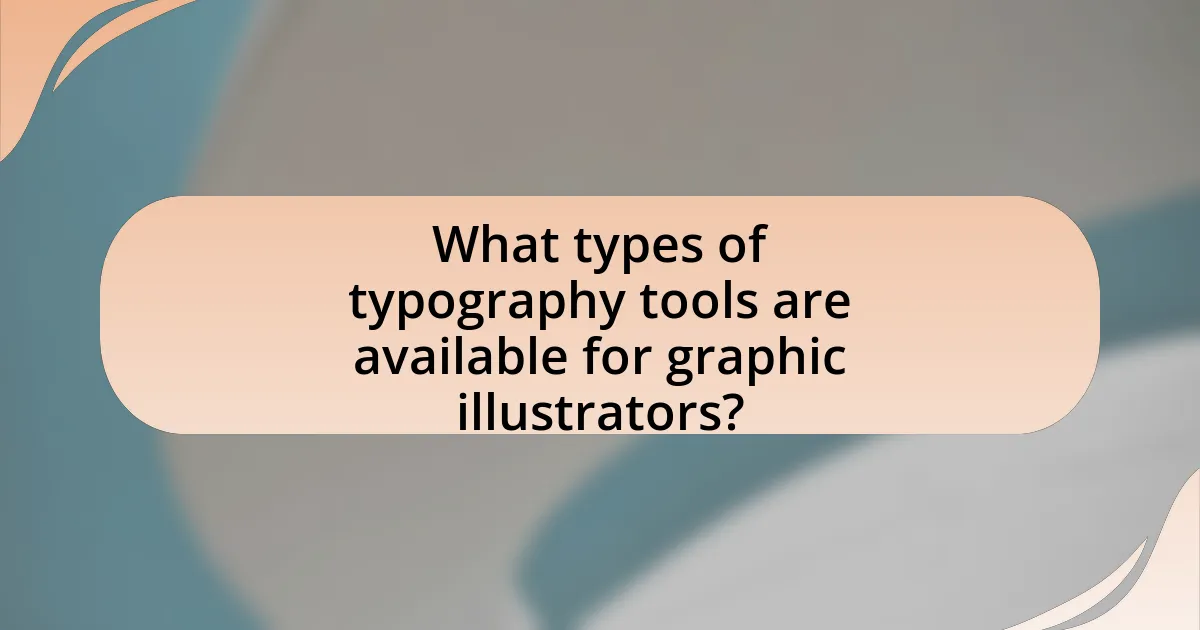
What types of typography tools are available for graphic illustrators?
Graphic illustrators have access to various typography tools, including software applications, online platforms, and physical tools. Key software applications include Adobe Illustrator, which offers advanced typography features, and Adobe InDesign, known for its layout capabilities. Online platforms like Canva provide user-friendly typography options for quick designs. Additionally, physical tools such as typography books and reference guides help illustrators understand typefaces and their applications. These tools collectively enhance the ability of graphic illustrators to create visually appealing and effective typographic designs.
What are the differences between software and hardware tools for typography?
Software tools for typography primarily involve digital applications that allow users to create, edit, and manipulate text, while hardware tools refer to physical devices used in the printing or display of typography. Software tools, such as Adobe Illustrator and InDesign, provide extensive features for font selection, layout design, and text effects, enabling precise control over typographic elements. In contrast, hardware tools, like printers and typesetting machines, are responsible for the physical output of typography, translating digital designs into tangible formats. The distinction lies in the fact that software tools focus on the creative and design aspects, while hardware tools are concerned with the production and reproduction of typographic work.
Which software tools are most popular among graphic illustrators?
Adobe Illustrator and Adobe Photoshop are the most popular software tools among graphic illustrators. These tools are widely used due to their extensive features that cater specifically to illustration and design needs. Adobe Illustrator is favored for its vector graphics capabilities, allowing for scalable artwork without loss of quality, while Adobe Photoshop is preferred for raster graphics and photo editing. According to a survey conducted by the Graphic Artists Guild, over 70% of professional illustrators reported using Adobe Illustrator, and around 65% use Adobe Photoshop, highlighting their dominance in the industry.
What hardware tools can enhance typography work?
Hardware tools that can enhance typography work include high-resolution printers, graphic tablets, and specialized keyboards. High-resolution printers ensure that printed typography maintains clarity and detail, which is crucial for professional presentations. Graphic tablets allow for precise control over typography design, enabling designers to create custom lettering and manipulate text with ease. Specialized keyboards, often equipped with programmable keys, can streamline the workflow for typographers by allowing quick access to frequently used functions and shortcuts. These tools collectively improve the quality and efficiency of typography work in graphic illustrations.
How do typography tools vary by design style or project type?
Typography tools vary significantly by design style and project type, as different styles require distinct approaches to font selection, layout, and overall visual hierarchy. For instance, a minimalist design style often utilizes clean, sans-serif fonts and ample white space, necessitating typography tools that emphasize simplicity and readability, such as Adobe Fonts or Google Fonts. In contrast, a vintage design style may rely on decorative serif fonts and intricate layouts, requiring tools like FontForge or Glyphs that allow for more creative manipulation of typefaces. Additionally, project types such as branding or web design may prioritize responsive typography tools that adapt to various screen sizes, like Figma or Sketch, while print projects might focus on tools that ensure high-resolution output, such as InDesign. This variation is supported by the fact that different design contexts demand specific functionalities and aesthetics from typography tools to effectively communicate the intended message.
What tools are best suited for digital illustrations?
The best tools for digital illustrations include Adobe Illustrator, CorelDRAW, and Procreate. Adobe Illustrator is widely recognized for its vector graphics capabilities, allowing artists to create scalable illustrations with precision. CorelDRAW offers a user-friendly interface and robust features for both vector and raster graphics, making it suitable for various illustration styles. Procreate, popular among digital artists using iPads, provides an intuitive touch interface and a wide range of brushes and tools tailored for illustration. These tools are favored in the industry due to their versatility, extensive features, and support for professional workflows.
Which typography tools are ideal for print design?
Adobe InDesign, Adobe Illustrator, and QuarkXPress are ideal typography tools for print design. Adobe InDesign is widely used for layout design, offering advanced typography features such as text styles, kerning, and tracking adjustments. Adobe Illustrator excels in creating vector graphics and allows for precise control over typography, making it suitable for custom type designs. QuarkXPress provides robust layout capabilities and supports extensive typographic controls, making it a preferred choice for professional print publications. These tools are recognized in the industry for their effectiveness in managing typography in print media.
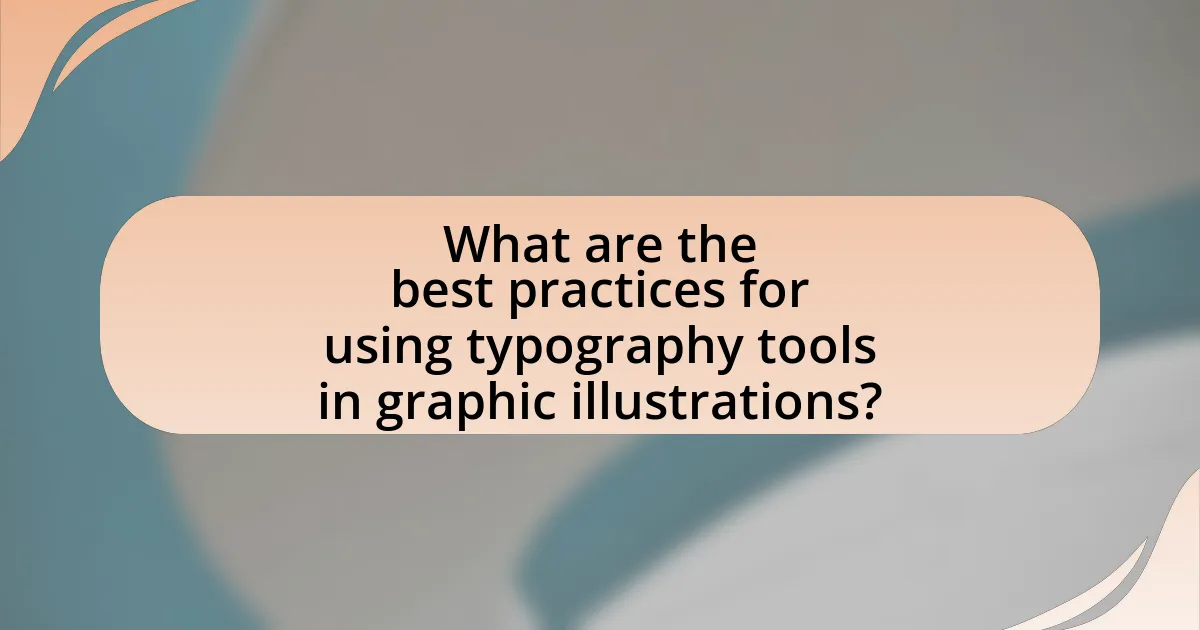
What are the best practices for using typography tools in graphic illustrations?
The best practices for using typography tools in graphic illustrations include selecting appropriate fonts, maintaining readability, and ensuring visual hierarchy. Selecting fonts that align with the overall design theme enhances the message and aesthetic appeal. Maintaining readability involves choosing font sizes and styles that are legible at various scales, which is crucial for effective communication. Establishing visual hierarchy through font weight, size, and spacing guides the viewer’s eye and emphasizes key information. These practices are supported by design principles that emphasize clarity and engagement in visual communication.
How can illustrators effectively choose typography tools for their projects?
Illustrators can effectively choose typography tools for their projects by assessing their specific design needs, understanding the characteristics of different typography tools, and evaluating user-friendliness and compatibility with their existing software. For instance, tools like Adobe Illustrator and InDesign offer extensive typography features, including advanced text manipulation and a wide range of font options, which are essential for professional-quality illustrations. Additionally, considering the project’s target audience and the emotional tone of the design can guide illustrators in selecting fonts that resonate well. Research indicates that the right typography can enhance readability and user engagement, making it crucial for illustrators to prioritize tools that align with their creative vision and project requirements.
What factors should be considered when selecting typography tools?
When selecting typography tools, key factors include usability, compatibility, and the range of features offered. Usability ensures that the tool is user-friendly, allowing designers to work efficiently without a steep learning curve. Compatibility with various design software and formats is crucial for seamless integration into existing workflows. Additionally, a diverse range of features, such as font libraries, customization options, and collaboration capabilities, enhances the tool’s effectiveness in meeting specific design needs. These considerations are supported by industry standards that emphasize the importance of efficiency and flexibility in design processes.
How can illustrators stay updated on new typography tools?
Illustrators can stay updated on new typography tools by regularly following design blogs, subscribing to industry newsletters, and participating in online design communities. These platforms often feature the latest tools, trends, and updates in typography, ensuring that illustrators have access to current information. For instance, websites like Creative Bloq and Smashing Magazine frequently publish articles on new typography software and tools, while forums such as Behance and Dribbble allow illustrators to share and discover innovative typography techniques. Engaging with these resources helps illustrators remain informed and enhance their skills in typography.
What common challenges do illustrators face with typography tools?
Illustrators commonly face challenges with typography tools, including limited font selection, compatibility issues, and difficulty in achieving desired text effects. Limited font selection restricts creativity, as many typography tools may not offer a diverse range of typefaces, impacting the overall design. Compatibility issues arise when typography tools do not integrate well with other design software, leading to workflow disruptions. Additionally, achieving specific text effects, such as kerning and leading adjustments, can be cumbersome in some tools, making it hard for illustrators to fine-tune their typography to match their artistic vision. These challenges can hinder the effectiveness of typography in graphic illustrations, ultimately affecting the quality of the final product.
How can these challenges be overcome?
To overcome challenges in typography for graphic illustrations, designers can utilize specialized software tools that enhance text readability and visual appeal. For instance, programs like Adobe Illustrator and InDesign offer advanced typography features, such as kerning, leading adjustments, and font pairing suggestions, which help in creating visually balanced designs. Additionally, adhering to established typographic principles, such as contrast and hierarchy, can significantly improve the effectiveness of text in illustrations. Research indicates that effective typography can increase user engagement by up to 50%, highlighting its importance in graphic design.
What troubleshooting tips can help improve typography work?
To improve typography work, ensure proper font pairing by selecting complementary typefaces that enhance readability and visual appeal. Research indicates that using contrasting fonts for headings and body text can significantly improve user engagement and comprehension. Additionally, check for consistent spacing and alignment, as uneven spacing can disrupt the flow of text and negatively impact the overall design. Studies show that proper kerning and leading can enhance legibility, making the text more accessible to readers. Lastly, always review typography on multiple devices to ensure it appears correctly across different screen sizes and resolutions, as this can affect the user experience.
What are some practical tips for mastering typography tools in graphic illustrations?
To master typography tools in graphic illustrations, focus on understanding the software features, practicing regularly, and studying design principles. Familiarize yourself with tools like Adobe Illustrator or InDesign, as they offer advanced typography options such as kerning, leading, and tracking adjustments. Regular practice enhances your skills, allowing you to experiment with different typefaces and layouts. Additionally, studying design principles, such as hierarchy and contrast, helps in making informed choices about typography, ensuring effective communication in your illustrations.
